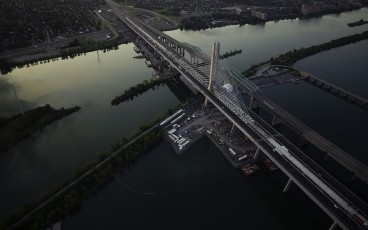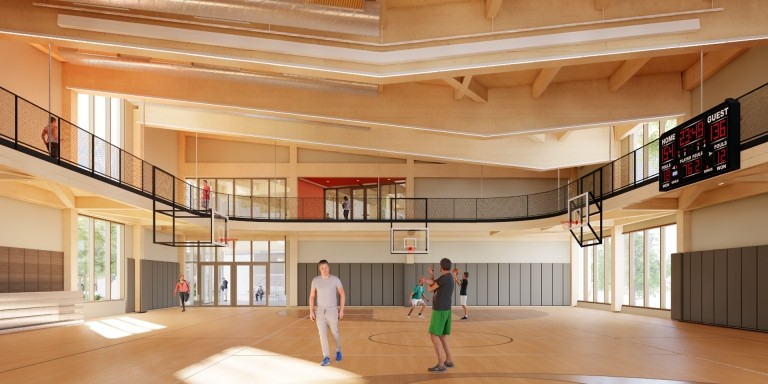T.Y. Lin International Wins Three 2020 Engineering Excellence Awards from American Council of Engineering Companies of California

T.Y. Lin International (TYLI), a globally recognized full-service infrastructure consulting firm, announces that three TYLI projects have won awards in the American Council of Engineering Companies of California (ACEC California) 2020 Engineering Excellence Awards (EEA) competition. The North Atwater Non-Motorized Multimodal Bridge in Los Angeles, California, and the Samuel De Champlain Bridge in Montréal, Québec, Canada, received Honor Awards. The Ontario International Airport - Taxiway S & W Intersection Evaluation and Repair in Ontario, California, was recognized with a Commendation Award.
ACEC California’s annual EEA competition recognizes outstanding achievements in engineering and land surveying projects completed by California firms. TYLI joined its project partners in accepting the awards at the ACEC California 2020 EEA dinner on February 13, 2020, in Los Angeles.
About the North Atwater Non-Motorized Multimodal Bridge:
Under an on-call contract with the City of Los Angeles Department of Public Works, TYLI provided construction engineering and significant design support throughout construction for the North Atwater Non-Motorized Multimodal Bridge. The first of a trio of bridges to be completed in the Glendale Narrows section of the Los Angeles River in Los Angeles, California, the new 325-foot‑long bridge is the first cable-stayed bridge in Los Angeles and possibly the first cable-stayed equestrian bridge in the world.
Featuring a dramatic, 125‑foot‑high mast and steel suspension cables, the signature bridge is located between the rapidly growing community of Atwater Village and Griffith Park, one of the largest urban parks in the United States. The bridge carries two separate decks: a 12-foot‑wide hardwood deck with stainless steel mesh railings for pedestrians and cyclists, and a 12‑foot‑wide equestrian side topped with horse-friendly rubber paves and a less transparent wooden picket railing system.
The dynamic behavior of the bridge was a major design consideration due to its very slender, lightweight deck and relatively heavy equestrian live loads. To mitigate the potential for resonant vibrations as groups of riders cross the bridge, a system of tuned mass dampers was designed. The dampers reduce the magnitude of vibrations during severe equestrian loading to an acceptable range and prevent vibrations from continuing after the horses have passed off the bridge.
Now providing a safer, more efficient route, the North Atwater Non-Motorized Multimodal Bridge connects users to the Los Angeles River Bike Path and Los Angeles River Greenway Trail that run along both banks of the river. The new bridge was completed ahead of schedule on October 31, 2019.
About the Samuel De Champlain Bridge:
TYLI served as the managing partner of the Bridge Engineering Joint Venture (BEJV) for the new Samuel De Champlain Bridge in Montréal, Québec, Canada, and Engineer of Record for the cable-stayed bridge main span over the Saint Lawrence River. The firm was also in charge of design quality management and served as the quality control design checker for the 1.75 miles of approach spans. The BEJV partners for the design-build project are TYLI Canada, Inc., International Bridge Technologies Canada, Inc., and SNC-Lavalin Inc.
The 2.1-mile lifeline bridge comprises three independent structures: the 1,736-foot-long, asymmetric cable-stayed bridge with its a single, 555-foot-high tower and stay cables in aesthetic harp arrangement; the 2,500-foot-long East Approach; and the 6,706-foot-long West Approach. The superstructure design includes two three-lane corridors for vehicular traffic with 2-foot by 10-foot shoulders each, a transit corridor for a light-rail transit system, and a multi-use path for pedestrians and cyclists.
Site challenges for the Samuel De Champlain Bridge project included severe winter conditions, wind and seismic hazards, strict navigational requirements, and construction in an urban center. The design-build team took a holistic approach in meeting the durability objectives, considering aspects such as environmental exposures, design detailing, materials selection, and construction quality, resulting in a bridge with a design life of 125 years.
Fully opened to traffic on July 1, 2019, the Samuel De Champlain Bridge is one of the highest-profile projects in North America and exemplifies innovation in bridge design and construction under rigorous project criteria and site challenges. The project teams utilized precasting, modular segments with post-tensioning, and creative erection sequencing, ultimately achieving an accelerated schedule of only 48 months from bridge design to traffic opening.
About the Ontario International Airport - Taxiway S & W Intersection Evaluation and Repair:
TYLI served as the Prime Design Consultant and Engineer-of-Record for the Ontario International Airport (ONT) - Taxiway S & W Intersection Evaluation and Repair in Ontario, California. The design was partially completed under a TYLI On-Call design contract with Los Angeles World Airports (LAWA). When the City of Ontario assumed ownership of ONT on November 1, 2016, TYLI completed the design under a new contract with the newly formed Ontario International Airport Authority (OIAA).
Although the project design was completed under the direction of two separate clients, TYLI’s role as the primary designer was to ensure that the technical and regulatory requirements were met regardless and that the clients’ operational needs and requirements were always a top priority. Project scope included: the investigation of the causes of the deteriorated taxiway pavement; the complete removal and replacement of the Portland Cement Concrete (PCC) pavement, including stabilization of the underlying base course and subgrade; the removal and replacement of in-pavement centerline and runway guard lights (RGL); and new pavement markings.
Also included in the project was the construction of a bypass taxiway to allow for uninterrupted access to tenants’ leaseholds to the southeast, including an adjacent UPS air-cargo facility. Scope also included the relocation of a service road and blast fence and complete site drainage.
The Airport Improvement Program (AIP)-funded project was bid in June 2017, with actual construction beginning in January 2018. The project was completed in December 2018, with almost no disruptions to daily operations at ONT.
Related News
-
Mar 26, 2024
Buildings Sector, Winter 2023-24: Openings, Awards, and On the Boards
AwardsProject NewsProject CompletionsProject Milestones -
Feb 21, 2024
Sharon Humphreys Joins TYLin in Southern California as Program Director, Rail + Transit
Company NewsNew Hire -
Jan 30, 2024
TYLin Announces New Buildings Sector Promotions
PromotionCompany NewsPeople



